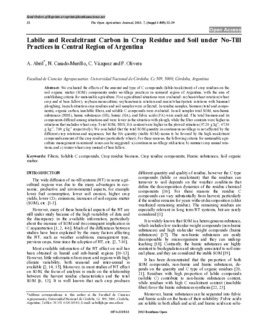| dc.contributor.author | Abril, Adriana | |
| dc.contributor.author | Casado Murillo, Noelia | |
| dc.contributor.author | Vázquez, Carolina | |
| dc.contributor.author | Olivera, P. | |
| dc.date.accessioned | 2022-05-12T13:30:51Z | |
| dc.date.available | 2022-05-12T13:30:51Z | |
| dc.date.issued | 2013 | |
| dc.identifier.citation | Abril, A., Casado Murillo, N., Vázquez, C. y Olivera, P. (2013). Labile and recalcitrant carbon in crop residue and soil under no-till practices in central region of Argentina. The Open Agriculture Journal 7, 32-39. http://dx.doi.org/10.2174/1874331501307010032 | |
| dc.identifier.uri | http://hdl.handle.net/11086/24821 | |
| dc.identifier.uri | http://dx.doi.org/10.2174/1874331501307010032 | |
| dc.description.abstract | We evaluated the effects of the amount and type of C compounds (labile/recalcitrant) of crop residues on the
soil organic matter (SOM) components under no-tillage practices in semiarid region of Argentina, with the aim of
establishing criteria for sustainable agriculture. Five agricultural situations were evaluated: soybean/wheat rotation (wheat
crop and at bare fallow); soybean monoculture; soybean/maize rotation and maize/wheat/potato rotations with biannual
ploughing. In each situation crop residues and soil samples were collected. In residue samples, biomass (total and components), organic carbon, insoluble fibers, and soluble C compounds were evaluated. In soil samples total SOM, non-humic
substances (NHS), humic substances (HS), humic (HA), and fulvic acids (FA) were analyzed. The total biomass and its
components differed among situations and were lower in the situation with plough, while the fiber contents were higher in
situations that includes wheat crop. Total SOM, NHS, HA content were higher in the plowed situation (57.20 g kg -1 , 47.30
g kg -1 , 7.80 g kg -1 respectively). We concluded that the total SOM quantity in continuous no-tillage is not affected by the
different crop rotations and sequences, but the HA quantity (stable SOM) seems to be favored by the high recalcitrant
compounds amount of the crop residues (particularly wheat). For these reasons, the following criteria for sustainable agriculture management in semiarid zones can be suggested: a) continuous no-tillage utilization; b) summer crop annual rotations; and c) winter wheat crop instead of bare fallow. | es |
| dc.language.iso | eng | es |
| dc.rights | Atribución-NoComercial 4.0 Internacional | * |
| dc.rights.uri | http://creativecommons.org/licenses/by-nc/4.0/ | * |
| dc.source | The Open Agriculture Journal, 2013; 7, 32-39 | |
| dc.source | ISSN 1874-3315 | |
| dc.source.uri | https://openagriculturejournal.com/index.php | |
| dc.subject | Carbono | es |
| dc.subject | Residuos de cosechas | es |
| dc.subject | Biomasa | es |
| dc.subject | Materia orgánica del suelo | es |
| dc.title | Labile and recalcitrant carbon in crop residue and soil under no-till practices in central region of Argentina | es |
| dc.type | article | es |
| dc.description.version | publishedVersion | es |
| dc.description.fil | Fil: Abril, Adriana. Universidad Nacional de Córdoba. Facultad de Ciencias Agropecuarias. Cátedra Microbiología Agrícola; Argentina. | es |
| dc.description.fil | Fil: Casado Murillo, Noelia. Universidad Nacional de Córdoba. Facultad de Ciencias Agropecuarias. Cátedra Microbiología Agrícola; Argentina. | es |
| dc.description.fil | Fil: Vázquez, Carolina. Universidad Nacional de Córdoba. Facultad de Ciencias Agropecuarias. Cátedra Microbiología Agrícola; Argentina. | es |
| dc.description.fil | Fil: Olivera, P. Universidad Nacional de Córdoba. Facultad de Ciencias Agropecuarias; Argentina. | es |





